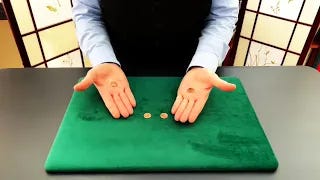
(Spoiler alert: Today’s entry reveals the secret to a sleight-of-hand trick.)
One of the first tricks I ever learned didn’t come from the usual sources I had as a kid, namely, magic kits, books or single tricks off the rack at the mecca of my youth, Ed Guth’s Hobby Shop in Syracuse, New York. No, one of the first tricks I learned, and the one I have performed the most, was taught to me one Saturday morning by a magician named Ed Hutchison, who ran a magic shop out of his basement in a Syracuse suburb.
The trick goes like this: A spectator places a penny in each of the magician’s hands. The magician closes her hands into fists and the spectator places another penny on the fingernails of either hand so the magician has two pennies in each hand. The magician flicks her wrists, catches the coins,, and when she opens her hands, there is one penny in one hand and three in the other! One coin has flown invisibly from hand to hand.
That is the basic description and in most cases—or so we magicians like to believe—is what the spectator remembers. What really happens is that the trick always happens twice. The first time the magician flicks her wrists, one hand catches both its pennies, while the other hand tosses both its coins to the table. The illusion is that one coin fell from each hand, when in fact the magician is left with two coins in one fist and none in the other. The magician goofed, in other words. When the trick is repeated, the magician is left with one penny in one hand and three in the other.
You can see exactly what this looks like and learn this trick right now or download the video for later.
In other words, every time you do this trick, you mess up the first time. You have to in order to set yourself up for success. This means that, in effect, you have to lie.
I’ve done this trick perhaps a thousand times over the years, with any small object you can think of—after-dinner mints, dice, jelly beans, even pebbles found on the side of a road one morning in Mexico. When I come to that mess-up moment, I often say something like, “Oops, that’s the first time I’ve tried it like this with [object].” And that is the way I teach it to my magic students. Does this mean I am teaching children to lie?
As magician Joshua Jay once pointed out in his podcast, “How Magicians Think,” in fact we magicians lie every time we perform a trick. We practice a theatrical art of deception. But one could say the same of any other theatrical work, be it a play or a movie. Even biopics about real people use illusion—fake buildings, recreated scenery and at least some made-up dialogue—to achieve the desired artistic effect.
Okay. Sure. But still, how does the magician live with lying outright, and how is this okay to teach to young people? It is in fact one of the challenges of performing magic that one has to lie. Some magicians, myself included, find their hands shaking sometimes partly due to nerves, but also because our hands are lying. The body is struggling with something the mind is trying to make it do that creates what I call physiological dissonance. It can take years of practice and countless hours performing to get over this and realize that the smaller untruths we employ in our magic serve the larger truth of our performances—that a love of magic, a love of mystery, matters and can be very, very meaningful.
Here is what I teach: You are actually telling the truth if you say it’s the first time you’ve done The Traveling Penny the way you’re doing it. Because you truly never have done this trick, and will never do this trick again, in exactly this way, with these objects, at this time, on this day, wearing what you’re wearing and for this particular person in this particular place. Every moment we live is unique, and we never experience any moment of our lives in exactly the same way again. Consider how very precious that is, every 60 seconds of heart beating, lungs breathing, brain thinking and our spirit—or whatever you call the software running your particular mind and body—our spirit nudging us to make the choices we make.
In the minute it takes to perform The Traveling Penny, a little copper coin isn’t the only thing that flies through the air invisibly. You create a moment of connection between you and your spectator. You transmit unseen waves of wonder. They smile, you smile, and for a precious minute you are riding along the same frequency and are in tune, enjoying a little spiritual resonance, brought to you by magic. Something true.
That is how to lie—with love.
Postscript: In researching this piece, I discovered that Ed Hutchison, the magic shop owner who taught me my most-performed trick, died last year at the age of 80. He and his wife, Jean, were married 60 years and had three children and eight grandchildren. Ed was a member of the NAACP in Mississippi in the 1960s and was also a teacher and writer in addition to being a magician.
Ed, thank you. Time is fleeting, and I wish I’d used some of mine to contact you at some point over the years so you could know the profound influence you had on me. Then again, since you wrote a book on mindreading, maybe you already knew.




